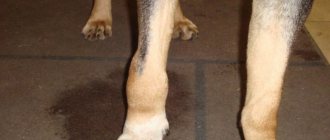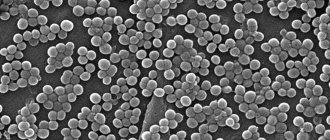Balanoposthitis in dogs - this term refers to the combination of an inflammatory process involving the head of the penis and its foreskin due to the intensive proliferation of pyogenic microflora (streptococci, staphylococci, candida fungi, Pseudomonas aeruginosa). Both an adult male and a young male can get sick. German shepherds and golden retrievers are most susceptible to balanoposthitis.
Owners of purebred dogs should keep in mind that ignoring the problem can lead to the inability to procreate. Inflammatory processes on the head of the penis occur in almost all male dogs, but usually everything goes away on its own, without visible consequences due to rapid self-healing.
What kind of disease is this
Balanoposthitis in dogs is a bacterial inflammatory process that occurs on the glans penis and prepuce. It can occur due to the fact that stagnation of sperm and urine occurs in the preputial sac. This disease is considered very common.
A photo of balanoposthitis in dogs is shown below.
As a result of inflammation, swelling of the organs occurs, and the dog experiences significant discomfort and pain. It should be noted that in males who have reached the age when they can give birth, the initial forms of balanoposthitis can often manifest themselves spontaneously. Mild forms of balanoposthitis in dogs do not pose a serious threat to the life and health of the animal and can even heal spontaneously. However, in cases where pathogenic microorganisms interfere with the inflammatory process, the disease can have serious consequences.
If such a disease is started, it can end in the loss of the sexual organ. In addition, in severe forms, the infection often spreads to the testes, and this already threatens the development of severe orchitis, which can later develop into peritonitis. There is a common belief among dog owners that balanoposthitis occurs only in old dogs, but this is a misconception. In the practice of veterinarians, there have been cases when this disease was diagnosed in puppies. Although this is rare, the consequences can be severe.
What do you prefer to feed your pets?
Poll Options are limited because JavaScript is disabled in your browser.
- Porridge with various additives 46%, 7427 votes
Owners of male dogs often notice purulent discharge around the prepuce or on the abdomen, sometimes their pet is overly interested in its genitals, the dog often licks the prepuce. This is how a fairly common pathology manifests itself - balanoposthitis. In some cases, follicles (vesicles) are observed on the mucous membrane of the penis, mainly at the base - this is the follicular form of balanoposthitis.
Why does balanoposthitis occur?
Balanoposthitis is an inflammation of the glans penis (Balanitis) and prepuce (posthitis). As a result of stagnation of urine and sperm in the preputial sac, pathogenic microflora multiplies, which leads to inflammation of the mucous membrane. The etiology of the follicular form of balanoposthitis is not fully understood; one of the reasons may be an allergic reaction. Also one of the reasons for the follicular form is a decrease in local immunity. Therefore, in the treatment of balanoposthitis, it is advisable to prescribe immunomodulators, for example Roncoleukin.
Attention: Only a doctor can prescribe immunomodulators, having assessed the animal’s condition and the advisability of their use in a particular case.
What to do if you notice discharge from the prepuce?
If you notice discharge from the prepuce, the first thing you need to do is examine the penis. It is more convenient to do this together. Lay your dog on his side. The helper should move the upper hind limb up and to the side so that you have access to your pet's abdomen. You need to fix the penis with one hand; to do this, grab it behind the bulbs - the thickening at the base of the penis. With your other hand, gently push back the prepuce. Carefully examine the mucous membrane of the penis, you should be alerted by redness, soreness, you may notice bubbles (follicles) at the base of the penis, closer to the bulbs, be sure to pay attention to whether there are any neoplasms or damage to the mucosa on the penis. Carefully inspect the opening of the urethra, make sure that no discharge is leaking from it.
Is it possible to cure balanoposthitis yourself?
If during the examination you see slight redness of the penis, there are no follicles, any neoplasms, injuries, bloody discharge on it, the urethra is clean and there is no pain when examining the dog, you can try to deal with it yourself. Most often, this is a common local inflammation; in order to cure it, it is necessary to sanitize (wash) the preputial sac 2-3 times a day, for this you can use the following solutions: chlorhexidine, miramistin, dioxidine. If your pet experiences heavy discharge after sanitizing the preputial sac, administer an antibacterial ointment; for this you can use Mastitis Forte, Tetradelta, or heated to a liquid state (but not hot) Levomekol.
Prepare everything you need in advance. Draw up the sanitation solution into a syringe (a 20ml syringe is best). Separately, prepare a syringe with ointment, if you use Mastitis Forte or Tetradelta, they come in convenient syringe tubes, you don’t need to pour them anywhere, and if you chose Levomekol, then squeeze a small amount of ointment into a 1-2 ml syringe and heat it under hot water , the ointment will quickly become liquid. Prepare a reservoir where the solution will drain after sanitation; you can use a cuvette or bowl for this.
Just like during an inspection, you will need an assistant. The dog must be secured in a position on its side. Your assistant, just as when examining the penis, lifts and fixes the upper hind paw. You need to pull the prepuce up a little so as not to injure the penis itself. Insert a syringe with a solution without a needle into the preputial opening, press the syringe plunger and inject the solution into the preputial sac, close the preputial opening by squeezing it lightly with your fingers so that the solution does not flow out immediately. Massage the prepuce with gentle movements to thoroughly wash off the products of inflammation and pathogenic microflora from the mucous membrane. Unclench your fingers and let the solution flow into the cuvette. Inject a small amount of ointment into the preputial sac, if required, and spread over the preputial sac with gentle massaging movements.
After carrying out such manipulations within 5-7 days, the discharge should disappear; if this does not happen, be sure to consult a doctor.
When can you not do without a doctor?
- If your pet, in addition to discharge, has a urinary pathology (lack of urination, difficulty or pain when urinating), you should immediately consult a doctor.
- If, upon examination of the penis, severe pain is observed, the animal becomes nervous and twitches when the preputial sac is palpated.
- If you find any formations on the penis or severe redness.
- If the discharge comes directly from the urethra.
- In case of frequent recurrence of the disease.
Not every dog owner knows about this disease, but balanaposthitis, unfortunately, is not such a rarity among canine diseases.
The essence of the pathology is the inflammatory process in the area of the prepuce and glans penis of the dog due to stagnation in the prepuce sac of smegma and urea.
The dog has balanoposthitis.
It occurs in mild and severe forms, and can have dangerous consequences. As a rule, the severe form has an irreversible process subsequently for the breeding value of the male, and such animals are considered unsuitable for selection.
Causes and symptoms
There are many factors influencing the occurrence of the disease and there is no one specific cause. This can be either a traumatic cause or an infectious disease.
The cause of the disease may be an infectious disease.
Factors
Provoking factors:
- consequence of phimosis;
- congenital predisposition;
- mechanical damage due to a foreign body;
- neoplasms;
- decreased immunity;
- diseases of the endocrine system -;
- injury;
- pathologies of the genitourinary system – , ;
- infections;
- improper care;
- obesity;
- sexual diseases.
Obesity is one of the factors that provokes the disease.
Signs
The signs of the development of balanoposthitis are specific and it is quite problematic to confuse them with the symptoms of another pathology.
Urination becomes painful.
- Dark yellow or brown discharge is recorded from the prepuce, which indicates the presence of pus. There is inflammation of the mucous membrane of the penis.
- The pet behaves restlessly and tries to avoid touching the sore spot.
- Miniature blisters may appear near the penis.
- The dog constantly licks the inflamed area.
- There is difficulty urinating or the absence of it as such.
- The hairy part of the diseased organ is dirty, covered in dried crusts of purulent discharge.
- Itching or burning sensations in the head area are possible. Sores or erosions form on the foreskin, the skin is swollen, and agitation is observed.
Reasons for the development of inflammation
The most common cause of balanoposthitis in dogs is the contamination of the prepuce with pathogenic microorganisms. This can occur against the background of various injuries (scratches and tears). Rarely, however, another factor that predisposes to the development of balanoposthitis is a tumor. Often the development of balanoposthitis in dogs occurs against the background of such an unpleasant disease as phimosis. This is a pathology, with the development of which there is a narrowing and shrinking of the foreskin, as a result of which the head of the penis is unable to return to its original place. Swelling and inflammation develop, the mucous membranes dry out and become a favorable environment for pathogenic microflora.
For some dog breeds, balanoposthitis is congenital and is caused by certain genetic defects. It most often affects German Shepherds and Golden Retrievers. Sometimes the causes of the development of phimosis and, as a consequence, balanoposthitis are swelling in the tissues of the preputial sac. As mentioned above, this occurs due to the contamination of injured areas with pathogenic or opportunistic microorganisms.
Preventive measures
All prevention of the occurrence of balanoposthitis comes down to the hygiene of the dog’s genital organs: washing the prepuce cavity after walking in “dirty” weather, avoiding sexually transmitted infections, etc.
For the purpose of prevention, you should visit the veterinarian once a quarter for an examination.
Inflammation of the mucous membrane of the glans or foreskin of the penis occurs not only in men, but also in many animals. Balanoposthitis occurs more often in dogs. It is found in dogs and puppies much less frequently than in humans. The disease is not always dangerous. At the initial stage, it does not cause concern to veterinarians and does not require treatment if accompanied by discharge in small quantities. At the same time, the dog shows absolutely no anxiety and feels comfortable. This is a mild balanoposthitis present in adult dogs. With this course of the inflammatory process, diagnostic tests or other tests are not required. This happens when there is a foreign body (grains of sand, small debris) that accidentally gets into the folds of the foreskin during a walk.
However, male dogs often have wounds, injuries, neoplasms, foreign bodies, infections and phimosis in the area of the penis, which lead to the development of more severe forms of balanoposthitis. Sometimes it develops in small puppies.
Symptoms of balanoposthitis
The most characteristic sign of the development of balanoposthitis in dogs is the presence of yellow or green purulent discharge that covers the tip of the prepuncial cavity. In 50% of diseases, blood discharge appears from the penis.
For most owners, the first and main reason to immediately contact a veterinarian is the dog’s constant licking of the genitals. Due to regular contact with saliva, the male dog's scrotum is constantly wet. In this way, he will try to reduce the pain that occurs during the development of inflammatory processes. Naturally, with such a disease, male dogs completely lack interest in mating. Even in cases where he has not lost the ability to mate, it is strictly forbidden to allow it, since purulent discharge and pathogenic microflora can lead to the development of the disease in the female.
Symptoms of balanoposthitis
The symptoms of the disease are very specific, and difficulties even with self-diagnosis almost never arise. A characteristic sign of pathology is the discharge of purulent contents from the preputial cavity. In approximately 5% of cases, animal owners note the presence of bloody discharge from the penis.
The reason for an urgent visit to the veterinarian is the dog’s constant licking of the scrotum and genital area. In this way, the animal tries to relieve pain and relieve other symptoms that are unpleasant for it.
Important. Sick males ignore females in heat. But even if interest remains, mating during the entire period of illness is strictly prohibited.
Typical signs of a dog having balanoposthitis are:
- purulent discharge from the prepuce;
- inflammation of the penile mucosa;
- pain in the groin area;
- formation of bubbles at the base of the penis;
- discharge from the urethra;
- the presence of edema of the foreskin and the development of erosions.
The dog urinates heavily and painfully. The animal may experience a constant erection caused by irritation of the glans penis.
Symptoms
In principle, the symptoms of this disease are quite characteristic, and therefore identifying it is not particularly difficult. We have already said that one of the most characteristic signs is the appearance of greenish or yellowish pus at the tip of the preputial cavity. In less than 50% of cases, bloody discharge from the penis itself is also detected.
For many dogs, the reason for an immediate visit to the veterinarian is the constant licking of the “lower regions”. The scrotum is sometimes constantly wet from saliva. This is how the animal tries to relieve pain and other unpleasant sensations from the developing inflammatory process. Of course, sick male dogs (for obvious reasons) do not show any interest in mating. Even if the dog is still capable of mating, it should not be allowed under any circumstances, because otherwise the pyogenic microflora is quite capable of infecting the bitch with something unpleasant.
Symptoms of balanoposthitis in dogs
- Yellow-green or yellow discharge (pus) visible on the spicule of the penis or prepuce.
- Sometimes bloody discharge from the foreskin or penis.
- There may be inflammation around the penis and swelling of the foreskin.
- Your pet may be anxious.
- The dog licks the foreskin excessively.
- During mating, the male does not show interest in the female, who is in heat.
- In advanced cases, appetite decreases or is absent, and body temperature may rise.
If you notice such signs in your pet, it is very important to promptly seek professional help from a veterinarian.
Diagnosis of balanoposthitis
Diagnosis of balanoposthitis in dogs is very simple. Often it is enough just to visually examine the male dog for the presence of inflammation of the tissues of the foreskin. It is very important to determine what exactly caused the development of the disease: pathogenic microorganisms or the presence of a foreign object in the foreskin. In addition, a study should be conducted to exclude the possibility of developing a tumor disease, because the treatment will be radically different.
In advanced cases, examination may require local anesthesia or general anesthesia, since the dog simply will not allow examination of the affected areas due to severe pain reactions. During the examination, the veterinarian will need to take all the necessary tests, with the most important being a wash and a smear. The samples taken will be sown on a nutrient medium. This will make it possible to quickly and very accurately determine the causative agent of the inflammatory process.
Therapy
Oddly enough, mild forms can be defeated even at home. The therapeutic process itself in this case is quite simple and unpretentious: you will simply need to rinse your dog’s preputial cavity for several days. Be careful! Since 1-3% hydrogen peroxide is used for this, your pet will obviously not be happy with the sensations that arise. It is very good to use a small soft rubber syringe for this operation. Of course, the rinsing solution must be fresh and warm. Treatment of the preputial cavity with furatsilin is also allowed.
Regardless of how to treat the disease, it must be done as carefully and carefully as possible. Do not allow the tip of the syringe to touch the head of the penis, as this can cause severe pain and discomfort to the animal. The foreskin is then gently massaged to remove excess fluid. It is also advisable to treat this area with some kind of liniment that has a healing and antimicrobial effect.
Not every owner of a four-legged friend knows that his pet can suffer from diseases of a very delicate nature. These diseases are most often quite dangerous and can lead to the most serious consequences. For example, even the best purebred male is rejected due to such diseases because he will not be able to bear offspring. Balanoposthitis is one of these serious diseases.
What is frostbite in dogs?
Frostbite is injury or death of the skin and other tissues caused by exposure to low temperatures.
In dogs, the most susceptible parts of the body to frostbite are the tips of the ears, tail, scrotum and toes. In animals, as in humans, when exposed to low temperatures in the body, blood flow is limited to the extremities and heat is maintained in the center of the body, that is, in the vital organs.
Therefore, if tissue begins to lose blood flow, it quickly becomes cold, freezes, and dies. Frostbite can occur not only when exposed to cold temperatures, but also when an animal is immersed in ice water.
What are the symptoms of frostbite in a dog?
Symptoms of frostbite can appear even within a few days, especially in dogs that are small in weight and size, the main symptoms are:
- Pale areas of skin that turn blue-white or gray from lack of blood flow;
- Skin that is cold to the touch or brittle;
- Ice may form around the affected area;
- Redness, swelling, blisters and ulcers appear;
- With severe frostbite, the skin or limbs turn black, this is called necrosis;
- Over several days and weeks, dead tissue sloughs off;
- There is pus, an unpleasant odor, and signs of a bacterial infection.
- Restoring blood flow in a frostbitten part of the body is accompanied by pain in animals.
Which dogs are susceptible to frostbite?
Almost all animals raised at home and not accustomed to the cold are susceptible to frostbite. Small breed dogs are most vulnerable; and short-haired breeds. If a dog suffers from various heart diseases, diabetes, or is on medication, then it is at risk. Even dogs living outdoors can be susceptible to frostbite if they do not have reliable shelter.
We recommend: How long should you walk your dog?
There are very few dog breeds that can withstand frost without problems.
How do I treat my dog's frostbite?
If there are symptoms of frostbite, the animal must be taken to a veterinarian, who will conduct various tests and prescribe a course of treatment.
First aid for hypothermia is as follows:
- Place the animal in a warm and dry place;
- If the dog has hypothermia, then eliminate this problem, it will be discussed below;
- Do not try to thaw a frostbitten area on your own, if you do not know how to do this, try calling a veterinarian and get advice, or better yet, take him to him right away;
- Gently warm the affected area with water heated to a temperature of about 40 C, check the temperature of the water by placing your hand there, you should feel comfortable, not cold or hot. Use warm compresses or soak the affected area in a bowl of warm water.
- Do not rub the frostbitten area, do not use dry heat (such as a heating pad or hair dryer) and do not use painkillers that can be toxic to your dog, take him to the veterinarian and he will tell you what to do.
Will my dog recover from frostbite?
If frostbite is not severe, then perhaps everything will work out or there will be minor damage to a part of the body; in more serious cases, frostbite can lead to surgery and amputation of the damaged part of the body.
Home treatment plan
A mild form of balanoposthitis can be cured without the help of a veterinarian. Home treatment for balanoposthitis in dogs is very simple. You will need to regularly wash your pet's prepuce cavity over several days. You should be careful when doing this. Since it is necessary to use a 1-3% hydrogen peroxide solution for rinsing, the dog may become aggressive due to the unpleasant sensations that arise. A small syringe made of soft rubber is well suited for such procedures. The rinsing solution must be fresh and warm. You can also treat the dog's preputial cavity with furatsilin.
Balanoposthitis in dogs should be treated at home very carefully and with extreme caution. Under no circumstances should the tip of the douche be allowed to touch the head of the penis - this can cause severe pain and aggression in the dog. After washing, the foreskin is gently massaged to remove excess fluid. It is also recommended that after all manipulations, treat the affected area with drugs that have antimicrobial effects and promote healing.
A very important condition in the treatment of balanoposthitis in dogs is to prevent the dog from licking the perineum throughout the entire period of therapy. The only reliable method is a surgical collar. If the disease is advanced and has become chronic, home treatment should be stopped and immediately consult a veterinarian.
Treatment
In mild cases of balanoposthitis, it is enough to wash the male dog’s foreskin and not let him lick it in order to prevent re-infection.
Severe, chronic or recurrent symptoms require treatment with a specific antibiotic and rinsing with an antiseptic solution. Additionally, antibiotic ointment is applied topically.
It is very important to follow the veterinarian's instructions throughout the entire period of therapy, the duration of which varies from person to person as it depends on various factors. To do this, the owner needs to be patient, since he constantly has to remove purulent secretions from furniture and carpets. For some, the noisy licking of a pet that is trying to get rid of mucus gets on their nerves.
Often, despite treatment, a relapse occurs, especially if the pet has a genetic predisposition. The risk of the infection returning can be minimized by constantly washing the foreskin with an antiseptic. When treatment does not help or the inflammation has become chronic, your veterinarian may recommend castration to permanently relieve the dog of its symptoms. However, even in this case, he will not guarantee that the dog will not get sick again.
Prevention
In order to somehow prevent the possibility of your pet contracting a disease such as balanoposthitis, you must adhere to the following rules:
- If there is dirt on the street or the dog has been digging in the ground, then after such a walk she definitely needs to wash her prepuce. The same applies to trips to the country or out of town.
- Carry out timely and thorough intimate hygiene of the dog.
- Once every two or three months, undergo a preventive examination by a veterinarian.
- Constantly wash the dog's foreskin with an antiseptic, which minimizes the likelihood of the disease returning.
Treatment by an experienced veterinarian
After contacting a specialist, first of all, a study will be conducted to find the cause of the disease. It is very important to find and remove all adhesions, tumors and scars that could lead to the development of phimosis and balanoposthitis in the dog. As in the case of the mild form, the dog will undergo daily rinsing of the preputial sac, but high-concentration solutions will be used, which are more effective. If the condition begins to worsen, treatment of balanoposthitis in the dog with antibiotics should be started.
Treatment of balanoposthitis
During diagnosis, the dog's blood and urine are examined; the doctor may also prescribe a test for genitourinary infections and, after a comprehensive analysis, recommend treatment for this problem.
Treatment of balanoposthitis in dogs depends on the form of the disease, but, as a rule, the dog is treated according to the following scheme:
- Having assessed the condition of the male dog, the doctor washes the prepuce (the procedure is carried out only inside the clinic). For this:
a) miramixin is mixed with chlorhexidine or dioxidine and the resulting solution is filled into a syringe without a needle; b) the male is fixed in a lying position using straps and one of the hind legs is moved to the side; c) a syringe filled with a solution is inserted between the shaft of the hollow penis and the retracted prepuce; d) the formed space is pressed with fingers and a light massage is performed, gradually introducing the solution into the preputial sac.
2. To get rid of the infection, use antibacterial ointment (Levomikol, Neomycin, Tetra-Delta), antibacterial (Metrogyl, Nitroxoline) and antifungal (Nystatin) drugs.
If the discharge does not disappear after taking medication, then you need to contact your veterinarian to adjust the treatment. In severe forms, treatment is carried out using a surgical method: the dog is removed dead tissue or completely castrated, removing the testes.
Follicular balanoposthitis in dogs: methods of diagnosis and treatment of the disease
Balanoposthitis in dogs is a rather delicate disease and occurs, as a rule, in males. There is a strong opinion among patients and veterinarians that balanoposthitis in dogs occurs only in older individuals. However, this statement is completely false. This scourge can even attack puppies. This article will discuss in detail the causes, symptoms, and treatment of balanoposthitis in dogs.
Symptoms of hypothermia (hypothermia) in dogs
For some reason, many beginners and even experienced dog breeders sincerely think that their pets don’t mind any frost. Of course this is not true. Not only small indoor dogs, but even huge mastiffs can become very cold if the ambient temperature is below all permissible values. And it’s good if the matter is limited to frostbite of the paws: general hypothermia in dogs is a dangerous condition, fraught with the development of many pathologies.
Antibiotics
When infectious processes become chronic, in addition to daily washing with antiseptic solutions, it is necessary to include antibacterial therapy in the treatment regimen. It often begins with taking a broad-spectrum antibiotic. After receiving the culture result, such an antibiotic can be replaced with another one that acts on certain microorganisms that have caused the development of inflammation.
An important role is played by antiseptic liniments, which are pumped into the prepuce cavity using a syringe. If for any reason the disease cannot be overcome, most often it is necessary to resort to castration.
Clinical picture of the disease
Symptoms of balanoposthitis in a male dog include the following clinical signs:
- A collection of yellowish or greenish-yellow exudate (pus) may be seen at the end of the foreskin or directly on the penis .
- From time to time, bloody discharge
.
- There may be swelling and inflammation of the tissue
around the penis/foreskin.
- The dog constantly and extremely “enthusiastically” licks
the area of his genitals so that the latter begin to literally “shine” from the abundance of saliva.
- The animal becomes apathetic, its appetite worsens
(in severe cases).
- Males completely lose interest in mating
.
- Lethargy, fever
and other signs of a severe pathological process are possible All these symptoms indicate that the “standard” course of balanoposthitis is complicated by some pathogenic microflora.
Susceptible animals and symptoms
Newborn puppies cannot regulate their body temperature , and therefore (if the mother is absent for a long time) their body may well become hypothermic, even if the ambient temperature is quite normal. Older and sick dogs are also more susceptible to cold and may also feel cold even if the room or enclosure is not cold. Hypothyroidism, as well as diseases of the hypothalamus (the part of the brain responsible for regulating body temperature), very often contribute to the development of hypothermia. Symptoms of hypothermia in dogs vary depending on the severity of the pathology and include the following clinical signs:
- Depression, the animal becomes apathetic and “lazy”, it is not interested in anything.
- A lethargic state is possible.
- Weakness.
- Well noticeable trembling of the limbs.
- Low heart rate (bradycardia).
- Labored breathing.
- Strongly dilated pupils, the size of which does not change in any way even in the light.
- Coma (with serious damage to internal organs and the central nervous system).
How is hypothermia diagnosed? This is quite easy to do. First, the specialist evaluates the signs of hypothermia in the dog described above (their presence and degree of manifestation). Then the veterinarian measures the body temperature of the injured dog, and then compares the obtained values with normal values. But the main task of a specialist is not to make a diagnosis, but to identify those pathologies that could arise under the influence of critically low ambient temperatures. For this purpose, the following studies are carried out:
- Blood biochemistry is very important , as it allows you to assess the condition of the kidneys, liver, identify pathologies of the pancreas and thyroid glands, determine the level of sugar, hormones and other compounds.
- A complete blood test, which allows you to detect infectious diseases, identify anemia, leukopenia or leukocytosis, and other pathologies of the hematopoietic system .
- It is also useful to check the blood serum for the ratio of calcium and phosphorus. These indicators are often impaired in moderate and severe types of hypothermia.
- Your veterinarian will test your urine to check for urinary tract infections and to more accurately determine kidney health .
- In old dogs, ultrasound examination of the thyroid gland , since ultrasound can determine its structure, outline the boundaries of the organ, and identify the presence/absence of inflammatory and degenerative processes.
- An electrocardiogram must be taken . Severe hypothermia has an extremely negative effect on the condition of the heart, so it is better to know about possible pathologies in advance.
General recommendations and forecasts
Despite the fact that the dog can often be completely cured, relapses occur quite often. Especially in cases where it was not possible to determine the cause of the disease. Very often, follicular balanoposthitis in dogs becomes chronic and, under favorable conditions, opportunistic microorganisms will cause pustular rashes in the foreskin area.
From time to time, you will still have to monitor the condition of your pet’s prepuce and rinse it with hydrogen peroxide. The prognosis for unadvanced cases is often favorable, however, if the first signs of balanoposthitis occur, you should immediately consult a specialist.
Disease prognosis and general recommendations
Balanoposthitis is prone to frequent relapses. Especially if the veterinarian was unable to determine the true cause of the development of the pathology.
The follicular form of balanoposthitis very often becomes chronic. And opportunistic microorganisms, with any weakening of the immune defense, will provoke a relapse of the disease.
To exclude the spontaneous appearance of the disease, the dog will need to examine the prepuce, assessing its condition, once every two to three months. It will also be necessary to perform sanitation with hydrogen peroxide.
The prognosis for mild forms of the disease is relatively favorable, but in advanced cases, balanoposthitis can make the dog neutered. For this reason, if characteristic symptoms appear, the animal must be immediately shown to a veterinarian.
Balanoposthitis in dogs - this term refers to the combination of an inflammatory process involving the head of the penis and its foreskin due to the intensive proliferation of pyogenic microflora (streptococci, staphylococci, candida fungi, Pseudomonas aeruginosa). Both an adult male and a young male can get sick. German shepherds and golden retrievers are most susceptible to balanoposthitis.
Owners of purebred dogs should keep in mind that ignoring the problem can lead to the inability to procreate. Inflammatory processes on the head of the penis occur in almost all male dogs, but usually everything goes away on its own, without visible consequences due to rapid self-healing.
Pathologies
The stage of the pathology can be judged by the intensity and nature of the clinical signs.
The onset of the disease manifests itself in the form of a scanty liquid secretion, which accumulates in the dog’s organ only in a supine position. The progression of the infection implies a change in the color and consistency of the secretion to white and thick in appearance. Then the pus itself accumulates.
In a supine position, a meager liquid secretion begins to accumulate.
According to the intensity, the pathology differs in its forms: simple, erosive, purulent-ulcerative, acute, gangrenous, chronic form.
Simple form
The simple form is expressed in the scarcity of manifestations and the rather calm behavior of the dog.
The simple form is characterized by the dog's calm behavior.
Erosive form
During the erosive form, the resulting pustules spontaneously open and turn into ulcers.
With the erosive form, the pustules begin to open.
Purulent-ulcerative form
The purulent-ulcerative form is characterized by further infection.
Acute form
The acute form is manifested by hyperthermia of the body, increased inflammation in the foreskin, and enlarged lymph nodes.
In the acute form of the disease, the dog's body temperature increases.
Gangrenous form
When the gangrenous form sets in, the animal becomes significantly weaker and the body temperature is constantly high.
The gangrenous form is expressed in constant weakness.
Chronic form
Chronic course implies constant pain at the site of inflammation, the appearance of cracks, scars on the foreskin. Chronic hyperthermia of the body, enlarged lymph nodes.
In the chronic form of the disease, the dog experiences constant pain.
Signs of balanoposthitis in dogs
The signs of the disease are specific, so they can be easily distinguished from other diseases:
- A brown or dark yellow discharge (sometimes mixed with blood) appears from the prepuce. Inflammation covers the head of the penis, possible fever and loss of appetite.
- The dog loses interest in mating even during his partner's heat.
- The animal is anxious and avoids touching inflamed parts of the body.
- Small pustules appear at the base of the penis.
- The dog constantly scratches and licks the head of the penis and its base. The skin swells, and small wounds or erosive formations form due to scratching.
- Due to the pathology, urination is impaired. The number of urinations per day decreases and then disappears altogether.
- The fur next to the diseased organ becomes sticky due to the accumulating pus, and an unpleasant odor appears. At the initial stage, the preputial sac is filled with a meager amount of liquid secretion mixed with sweat, only in a supine position. As the pathological process develops, the liquid thickens and acquires a more saturated color, and suppuration appears.
According to the severity of the course, balanoposthitis in dogs is divided into the following forms:
- Simple. The discharge is minimal and practically does not bother the dog.
- Erosive. The pustules burst, become inflamed and degenerate into ulcers.
- Purulent-ulcerative. Ulcers grow due to the addition of a purulent infection.
- Spicy. The pet's temperature rises and the inflammatory process intensifies, the lymph nodes increase in size.
- Gangrenous. The dog is weakened and constantly feverish.
- Chronic. The animal experiences constant pain in the inflamed organ, cracks form on the prepuce, scarring of damaged tissue occurs, and hyperthermia becomes chronic. After alarming symptoms occur, it is recommended to contact a veterinary clinic for diagnostics, allowing you to prescribe competent treatment for the animal.
Summarizing
Despite the fact that at the initial stage balanoposthitis does not threaten the life of the animal and does not cause severe pain, this disease, like any inflammatory process, negatively affects the general health of the dog. Therefore, treatment must be started as soon as possible from the moment the first symptoms are detected and done strictly under the supervision of a veterinarian. Then your beloved pet will recover faster, and the likelihood of a recurrence of the disease will decrease.
Inflammation of the prepuce in dogs occurs suddenly due to the accumulation of smegma and urea. Swelling and redness appear, which provokes severe pain and inflammation of the dog’s genital organ. Quite often it appears without any prerequisites and goes away without the use of drug therapy.
Infection and inflammation of the foreskin in dogs due to contamination by microbes may require castration if not treated in a timely manner, and when inflammation of the penis is present in the dog.
It occurs in almost all male dogs, has yellowish discharge, swelling, pain, and the appearance of ulcers in the surrounding area and is called balanoposthitis and inflammation of the penis in a dog.
Causes of the disease
If inflammation of the genital organs occurs in breeding animals, they are almost always rejected from further breeding. Even after successful treatment, their offspring have an increased risk of developing congenital pathologies.
The development of pathology is promoted by:
- genetic predisposition;
- presence of neoplasms;
- diseases of the endocrine and genitourinary system;
- poor hygiene;
- sexually transmitted diseases;
- excessive weight, which provokes the development of pathogenic bacteria in fat folds;
- narrowing of the prepuce (phimosis);
- foreign objects stuck between the foreskin and the shaft of the penis;
- allergic reactions;
- weakening of the immune system;
- infections of viral, fungal and bacterial etiology;
- genital injuries.











